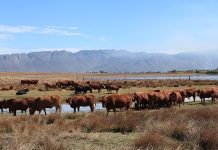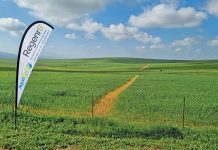Installing irigation and oversowing the mixed grass pasture with clover has enabled Zelda Brits to increase the Sterkfontein Kalahari Re goat Stud by one-third in a year – to 325 animals on just 6,5ha. Chris Nel visited her and her husband Attie again on their Bronkhorstspruit smallholding to get an updated on the latest development.
Farmer’s Weekly of 28 March 2008 carried an article on Zelda Brits’ Sterkfontein Kalahari Red goat stud, run on an 8,5ha smallholding on the farm Roodepoort in the Bronkhorstspruit district. The smallholding has two parallel intensive enterprises. Zelda’s husband Attie runs Sterkfontein Veevoere, complementing the stud, on 2ha.
Zelda’s goal is to breed productive meat-producing goats, while improving them in terms of the SA Boer Goat Breeders’ Society (SABGBS’s) breed standard.
“My long-term vision is to provide an excellent-quality stud goat to commercial farmers and stud breeders, but I’d also like to expand into the commercial goat meat market,” she explains. “In five years I’d like to be the biggest Kalahari Red breeder in South Africa, supplying the stud, commercial and slaughter market. In 10 years I’d like to be an established supplier to a group like Woolworths.”
But the herd is still being built up, and the demand for high-quality breeding stock is currently top priority. Sterkfontein now runs 325 goats, a one-third increase over 210 a year ago. Last year, Zelda sold 60 breeding ewes and rams for both stud and commercial purposes and 32 culled slaughter goats at a weekly local stock sale, averaging from R30/kg to R35/kg liveweight.
She wants to launch commercial goat meat production on the farm within the next two to three years, starting with at least 100 slaughter goats per year, or whatever the market demands.
Adapted to pasture
The goats are run year-round on 6,5ha pasture of Rhodes grass (Chloris gayana) and the Smuts finger grass (Digitaria eriantha) cultivar (cv) TipTop, which has narrower and softer leaves than cv Irene. The pasture also has self-seeding veld grass volunteers. Smuts finger grass grows tall and upwards, while Rhodes grass spreads horizontally, so they complement each other and maximise production.
In February, the pasture was oversown with arrowleaf clover (Trifolium vesiculosum) cv Zulu II to maintain the fodder flow in winter and fix nitrogen. Imported from Australia, it was broadcast into the pasture at a rate of 6kg/ha, seven days after the pasture had been mowed and baled for hay. It’s a high-producing, self-seeding annual pasture legume, ideal for winter grazing, and doesn’t cause bloat.
Goats are natural browsers but are highly adaptable and do very well on the pasture. However, young ewes get a daily supplement of pellets and chocolate maize.
Breeding the best
“In selecting replacement ewes I have to consider many factors,” says Zelda. “A ewe should lamb every eight months, or have really outstanding characteristics – such as growth or maternal instincts – to save her from being culled. As a goat ewe can easily rear twins, this is an important factor. “I select for maternal instincts and milk production by weaning lambs on weight, not age. A ewe with poor milk production will take longer to wean her lambs, conceive and lamb again. I also cull any ewe producing a lamb with a culling defect. Ewes also must be approved in terms of the breed standard, and any ewe not complying is culled.
“When selecting a ram, his mother’s history is important. I select according to my herd’s needs. For example, if some ewes lack length, I’d use a ram with good length on them. I use different rams with different groups of ewes.” Zelda uses a checklist of 32 characteristics to select and match ewes and rams. Heavily pregnant ewes are placed in individual lambing pens in the maternity enclosure, where they stay with their newborn lambs to bond. The lambs are weighed and ear-tagged before being put to pasture with their dams.
Thorough records
“I keep thorough records of my animals,” Zelda explains. “These include birth date and weight, dam and sire’s particulars, 100 days’ weight, 270 days’ weight, every vaccination and dosing, any treatment given and for what, and reproduction. The results, as well as any positive and negative remarks. For what purpose they were sold – stud, commercial breeding or culling – the buyer and the price.
“The Agricultural Research Council’s Shepherd computer programme is very useful for breeding management, but not general herd management. I do mating, birth registration and temporary indexes but have problems registering the second set of lambs from a ewe in one year with it, so I have to keep separate records.”
Goats are ear-tagged and their details are entered into a Shepherd programme. All ewes bought in from outside carry yellow tags on their right ears. Newborns are tagged at three days old with tags colour-coded per year. The year number (e.g., 8 for 2008) is followed by the serial number (-001 etc.). The registration number, obtained from the Registrar of Animal Improvement, is tattooed into the left ear at one month old.
Animals inspected by SABGBS selectors are classified as either stud or herd on conformation, irrespective of their pedigree. Stud, but not herd, animals are fitted with metal tags. Animals with eliminating faults are culled and may not be offered at an auction under the SABGBS. All animals are also registered with SA Studbook.
Health and vigour
Twice every day, early in the morning and late in the afternoon, the goats are exercised on a long walk in three groups – rams, mature ewes and mated young ewes and recently-weaned ewe lambs.In an intensive, high-density production system, diseases and parasites are more problematic with goats than under extensive free-range conditions. Zelda has a specific solution for each. As soon as an animal gets ill it’s immediately isolated and treated.
“As I always have lambs in the kraal, orf is difficult to eradicate. One month before the ewe is due to lamb, she’s vaccinated with Onderstepoort orf vaccine, and the lamb is vaccinated at 10 days. This vaccine isn’t always effective. If I get lambs suffering from orf I use a herbal ointment made from aqueous cream, comfrey and bulbinella, which can be applied on any area and usually clears it up in a week.” Coccidiosis isn’t common in adult animals, but heavy rain causes outbreaks, leading to losses. “All my lambs are dosed with Vecoxan at 14 days,” says Zelda. “As soon as I suspect an outbreak, the sick animals are isolated and treated. I then treat all my animals with either Vecoxan or Amprolium.”
“Ewes are inoculated annually against enzootic abortion and the rams against brucellosis with Brucella Rev 1,” says Zelda. “Adult animals are inoculated twice yearly against pasteurellosis in March and September, and pulpy kidney.”
Lambs are dewormed at 30, 60 and 90 days. At weaning they’re inoculated against pasteurellosis and pulpy kidney, and injected with Multimin+SE. They’re then incorporated into the herd’s normal veterinary programme. “Vigilance, correct diagnosis and immediate correct treatment limit losses,” says Zelda.
Many satisfied customers
“I don’t sell old ewes,” she stresses. “They may not adapt easily to their new environment. Even with an outstanding ewe this can damage your reputation. Young ewes adapt far more easily, and rams have few adaptation problems.
“I’ve received positive feedback from stud and commercial breeders who’ve bought goats from us. After our auction last year, I contacted all the buyers and no one had any complaints. I have a client in Botswana who only buys from us, and a lot of interest from neighbouring countries.”Contact Zelda Brits on 083 259 8178 or e-mail [email protected]. |fw








